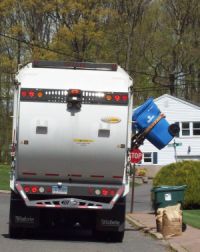Trends in Recycling Collection -
A Focus on Single Stream
Effects of Rapid Rise of Single Stream Recycling Vary by Sector:
|
Each collection method has its benefits. Automated pick-up results in lower collection costs for the hauler and fewer worker injuries and fewer workman compensation claims; larger recycling containers results in more material set-out for recycling and higher resident participation rates; single stream (collecting bottles, cans and paper mixed together) results in lower collection costs for the haulers and less separation effort and greater recycling participation rates for residents.
Implementing any or all of the collection options listed above, accompanied by increased educational outreach, expansion of the types of material collected for recycling, and the implementation of a SMART unit based pricing program may be a way to get Connecticut closer to the 60% disposal diversion goal by 2024.
There are many benefits and challenges to switch or change any recycling program. Switching to a new way of collecting materials requires forethought and planning to ensure residents understand how to prepare and provide materials at the curb or drop off facility. Haulers, sorters, processing facilities and end-markets, manufactures need to be part of the conversation too; not all companies will be able to accommodate the changes you wish to make, changing how you collect recyclables will change their business operation.
Is Single Stream Right for Your Community?
Benefits and Challenges
"In order to ensure an optimally functioning whole recycling system, local governments must provide for recycling services that sustain all parts of the cycle, not just collection. Therefore, in the same way that local governments specify collection service requirements, they should also specify processing and marketing requirements, with input and feedback from the industries that will use the recovered resources in the manufacture of new products."
For more details on benefits and challenges, please see our Single Stream FAQ webpage.
Communities around the country are continuously evaluating and changing their recycling collection programs to implement new technologies, including single stream. In FY2010, CT recycling facilities reported receiving residential single stream recyclables from 65 cities and towns. The following is a sampling of single stream programs and pilots found in Connecticut and other states.
Single Stream Recycling Programs in Connecticut:
Bristol, CT - conducted a pilot with 900 households, biweekly collection of recyclables, combined with new automated curbside collection system
Connecticut Resource Recovery Authority, which serves 118 communities in Connecticut, has added a single stream sorting line at their facility in Hartford
Granby, CT – SMART program, combined with curbside single stream recycling program
Hartford, CT - implemented a one-year pilot in May 2008 which combines single stream recycle collection, additional acceptable materials and Recyclebank, a reward program to their curbside collection program
Manchester, CT – semi-automated curbside collection – recycling collection is bi-weekly, started July 1, 2009
New Haven, CT - semi-automated curbside collection - phasing in single stream recycling (larger recycling bin, smaller trash bin) – one city district at a time, starting July 2010
Stonington, CT - SMART program, combined with curbside single stream recycling program
Single Stream Recycling Programs in Other States:
Arlington, VA - curbside collection includes electronic waste
Austin, TX – combined with pay-as-you-throw, starting October 2008
Baltimore, MD – expanded plastics to #1-#7 (only #1 & #2 before)
Boston, MA – after their pilot increasing barrel size, using clear bags, and adding automation, a single stream program was fully implemented July 2009. Update:"Single in Beantown" - Boston has seen mixed results since moving to single stream collection (Recycling Today 4/21/10).
Delaware Solid Waste Authority - 64-gallon wheeled cart. Brochure
Philadelphia, PA – no new bins, residents can use any type and as many bins as they’d like for their recyclables
San Francisco, CA – 3 cart system: single stream recycling, wet waste composting, garbage
Wilmington, DE – partners with RecycleBank
Single Stream Resources
Understanding Economic and Environmental Impacts of Single-Stream Collection Systems,
Container Recycling Institute (CRI), December 2009
Downstream of Single Stream, by the staff of Eureka Recycling, Article printed in Resource Recycling, November 2002
Single Stream: A Recycling Method That Cuts Both Ways, Steven R. Stein, Article printed in Resource Recycling, October 2004
Single Stream Recycling Best Practices Manual,
Susan Kinsella and Richard Gertman, February 2007
Single-Stream and Dual-Stream Recycling: Comparative Impacts of Commingled Recyclables Processing, Tim Goodman and Associates, January 2006
Single Stream Recycling Fact Sheet, Solid and Hazardous Waste Education Center, University of Wisconsin Extension
Collection Costs, EPA, last updated August 2008
To Single Stream or Not to Single Stream? US EPA Meeting, July 19, 2007 (slide show)
Single Stream Versus Multi-stream Recycling, by Darlene Snow, MSW Management, September-October 2003
Making the Grade: The Development of Single-Stream Collection Programs Has Polarized Some Consumers and Processors, by Dan Sandoval, Recycling Today, October 2002
Disclaimer: The Connecticut Department of Energy and Environmental Protection (DEEP) maintains the content on this web site to enhance public access to information and facilitate understanding of waste reduction, reuse and recycling. The DEEP is not recommending these resources over any others and recognizes these represent only a partial listing of resources on this subject.
Reduce/Reuse/Recycle
Content Last Updated February 2020

